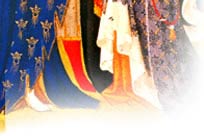 |
|||
 

|
Medieval History of Scotland The Middle Ages saw the birth of Scotland. This land had been under constant attack from Norsemen, Picts, Britons, Celts, and Angles, but Kenneth Macalpine, King of Scots, in 843 united clans and declared himself ruler of Scotia. He took the Stone of Destiny to Scone to be used for his coronation. This stone is traditionally regarded as the pillow Jacob used when he dreamt of a ladder carrying angels between heaven and earth. Generations of Scottish kings were crowned on a throne that housed this stone. William the Lion's ill-fated expedition to capture Northumberland in 1174 led to the humiliating Treaty of Falaise that placed Scotland under English rule. This rule was increasingly severe through the time of Edward I, who named himself overlord of Scotland. Scots patriot William Wallace, whose exploits were later immortalized in the movie Braveheart, resisted Edward and was later executed for this. Robert the Bruce went to Scone castle in 1306 and had himself named King, and went on to defeat Edward II's forces at Bannockburn in 1314 and win back Scottish independence. One of the oldest surviving Gaelic manuscripts is known as The Book of Deer is a tenth century illuminated manuscript from North East Scotland. This is the only pre-Norman manuscript from this area and its Latin text and Celtic illuminations give unique insights into the early church, culture and society of the Middle Ages. |
 |
|
 |
|||
 |
|||